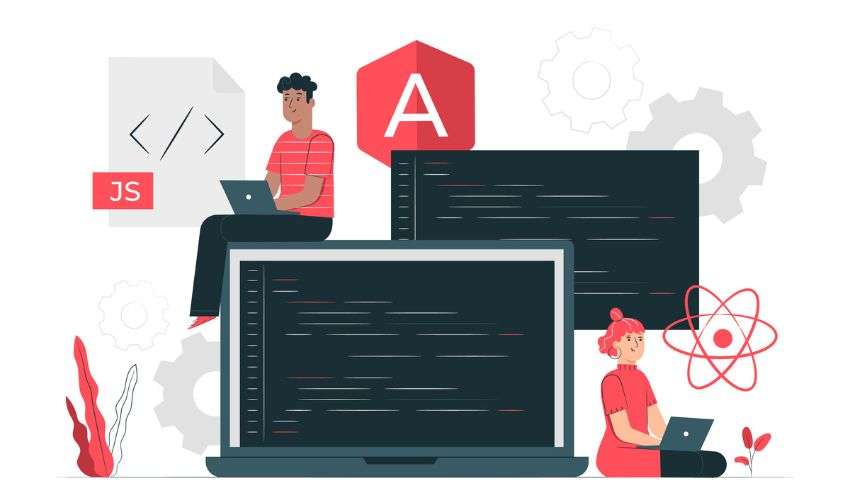Since its inception, Angular has continued dominating as one of many enterprises’ first choices for robust and dynamic web application development frameworks. With its game-changing features like virtual scrolling, two-way data binding, MVC architecture, and cross-platform compatibility, it has remained at the top in a rapidly evolving digital era.
In addition, every new release of Angular introduces advanced functionalities that simplify development. For example, the latest Angular 17 features include quicker recursive type checking, declarative control flow syntax with support for Typescript 5.2, optional support for ViewTransition API, automatic removal of CSS, and many more.
Our exploration of the top AngularJs framework in 2024 will give you better insights into its extensive ecosystem.
So, let’s delve into the context without much delay:
What is Angular Framework? – An Overview!
AngularJS is a renowned open-source front-end web framework primarily used to develop single-page applications (SPAs). With a community of developers and corporations, Google developed it to simplify modern web application development.
AngularJS provides a framework for client-side Model-View-Controller (MVC) and Model-View-View-Model (MVVM) architectures and components commonly used in web applications, simplifying development and testing.
What makes Angular the Prime Choice for Web App Development?
Angular comes with extensive features that make web app development quick and best-in-class. Developers can build intuitive and feature-rich web applications by leveraging its features and core components.
Here are a few prime reasons why Angular gives you an upper hand in web development compared to other frameworks:
- Two-way Data Binding – Angular’s two-way data binding feature ensures that any changes (regardless of size) made in the Model are reflected immediately in the View and vice versa. This synchronization between the Model and View helps to reduce the need for additional code to handle updates, thus simplifying the development process.
- MVC Architecture – The AngularJS framework’s Model-View-Controller (MVC) architecture simplifies code maintenance by allowing developers to workseparately on different application parts.
- Dependency Injection – Angular’s built-in dependency injection simplifies application development, comprehension, and testing by detachedly linking components and their dependencies.
- SPA Features – Angular frameworks are an excellent choice for developing single-page and progressive web applications, thanks to their routing, templating, and AJAX handling functionalities.
- Community & Ecosystem – As one of the early mainstream frameworks backed by Google, Angular has a large community and ecosystem. This means ample resources, libraries, tools, and knowledge in forums, tutorials, and professional networks are available.
Now that you know why Angular is the first choice framework for web development, it is time to explore top Angular frameworks in 2024.
Top 10 AngularJs Framework for Web Development 2024!
Let’s explore the exclusive list of top AngularJs frameworks and UI that have been pro-choice for enterprises for dynamic web application development:
- Mobile Angular UI:-
Mobile Angular UI combines AngularJs and Bootstrap – a popular framework for building scalable and mobile-friendly web applications. It comprises vital mobile components, like overlays, switches, top-bottom navigation bars, and sidebars, ensuring quick conversions of desktop web apps to mobile apps.
Pros –
- It belongs to the lightweight apps developing framework category.
- Auto-adjust layout feature helps create responsive mobile apps, as mobile devices come in various sizes.
Cons –
- There are certain limitations to the available resources, third-party integrations, and tutorials compared to other options.
- Bootstrap may not be ideal for projects that require a different UI framework or custom design solutions.
- Ionic
Ionic is a renowned, robust SDK that combines with AngularJs to develop super flexible cross-platform mobile applications. Leveraging its vast array of components and tools, developers build blazing-fast-speed, native-like mobile applications.
Pros –
- Single code and optimized performance.
- It offers a collection of UI components that are pre-designed and can be customized to meet native app standards.
Cons –
- It has a poor dependency management.
- Due to the SDK relying on advanced web capabilities, older devices and platforms may experience performance issues.
- Angular Material
The Angular Material is an implementation of Google’s Material design specification. It provides a unified set of reusable UI components, ensuring sleek, consistent, and functional interfaces for your application.
Pros –
- The user interface components are pre-designed, easy to use, and responsive, allowing quick customization.
- Prioritize accessibility for inclusive applications.
Cons –
- Using multiple material components can produce performance overhead, particularly in large-scale applications.
- Updates and changes in Angular affect the usage and functionality of Angular Material since it’s tied to Angular.
- LumX
LumX is a framework based on AngularJS that follows Google Material Design principles. It provides a customizable feature set built using Bourbon, Neat, and Sass.
Pros –
- LumX is lightweight.
- Developing applications that run seamlessly on multiple devices is now optimal due to its responsive design.
Cons –
- Compared to other Javascript frameworks, the frequency of updates in LumX is relatively low.
- The Material Design guidelines may limit design options for projects that require a different aesthetic.
- Angular UI Bootstrap
This framework includes a collection of AngularJS directives that use Bootstrap’s markup and CSS. It’s an ideal option for developers familiar with Bootstrap who want to integrate it seamlessly into their AngularJS applications.
Pros –
- AngularJS is used exclusively, eliminating the need for jQuery, simplifying development, and reducing overhead.
- Bootstrap components are converted into AngularJS directives for easy UI development.
Cons –
- Ensuring compatibility between Bootstrap and Angular UI Bootstrap versions is essential, especially as newer frameworks are released.
- Quantum UI
Quantum UI provides AngularJS developers with 25+ components and native services to create complex application interfaces easily.
Pros –
- Developers can choose specific components for a lighter application.
Cons –
- Compared to other well-established frameworks, less community support and documentation may be available.
- Angular Foundation
This framework combines AngularJS for application structure with the Foundation’s responsive design elements. It’s ideal for developers seeking a flexible and lightweight solution.
Pros –
- The combination of AngularJS and Foundation creates a responsive and adaptable user interface.
- It emphasizes flexibility and superior performance, making it a practical choice for developers seeking a streamlined solution.
Cons –
- Keeping the framework compatible with the latest versions of AngularJS and Foundation can be challenging as they evolve independently.
- Angular UI Grid
A grid system explicitly designed for AngularJS applications, offering sorting, filtering, and grouping features, making it an ideal data-intensive application.
Pros –
- You can use Angular UI grid to develop applications that efficiently handle large data sets.
Cons –
- When dealing with large datasets or implementing intricate functionalities, it is essential to optimize performance. This demands careful attention to detail and thorough optimization.
- PrimeNG
PrimeNG offers a wide range of UI components functional in AngularJS applications. The components have extensive themes and widgets and are typically associated with Angular.
Pros –
- It has a Rich UI component library.
- Customizing the appearance of your web apps is effortless with various templates and themes.
Cons –
- Adding too many components and features can negatively impact the performance of large-scale applications.
- Radian
Radian utilizes the AngularJS framework to implement custom HTML elements and enable two-way data binding between HTML and JavaScript elements. It excels in managing large datasets and complicated UI components.
Pros –
- Radian uses the AMD (Asynchronous Module Definition) for efficient script loading, which improves performance, particularly in complex applications.
Cons –
- The additional features and capabilities designed for complex applications can introduce unnecessary overhead for more straightforward ones.
Bottomline:
These libraries and frameworks are meant to complement AngularJS by adding extra features, simplifying certain tasks, or addressing specific development needs. However, developers must carefully evaluate their project requirements, scalability needs, and the specific advantages of each framework to determine the most suitable one. Factors such as application size, performance requirements, design aesthetics, and the existing skill set of the development team play a significant role in this decision-making process.
Hire Angular Developers from a renowned Angular Development Agency to enable the best version of the AngulraJs framework into your existing or running project and enjoy the best possible outcome.










